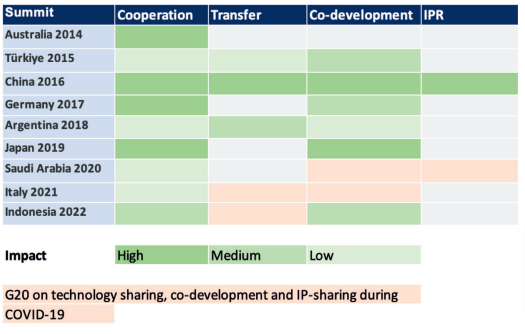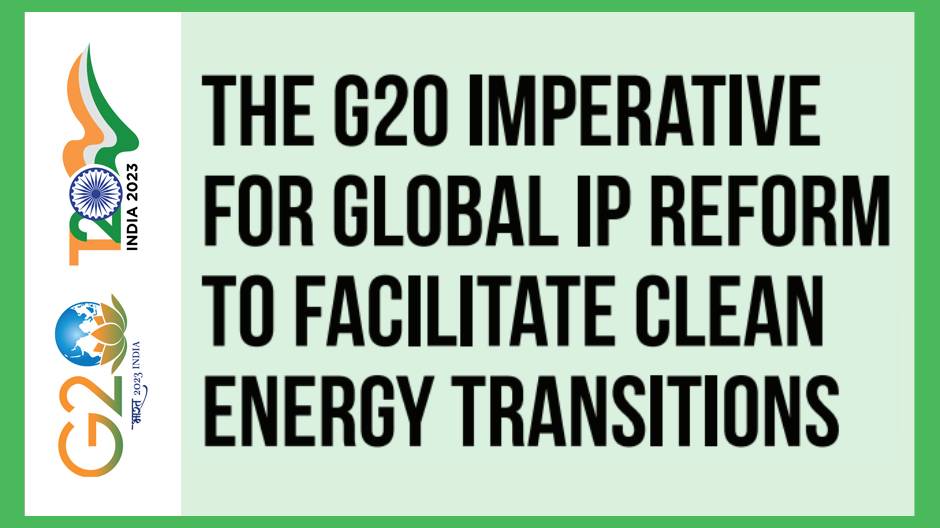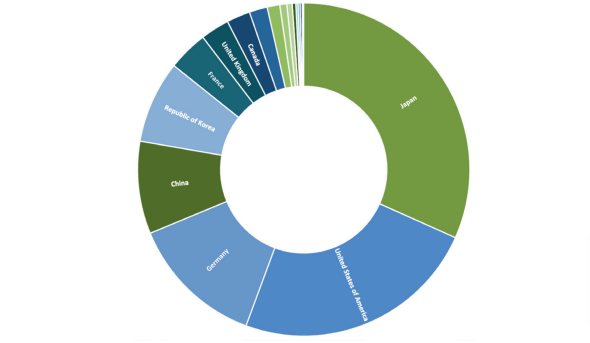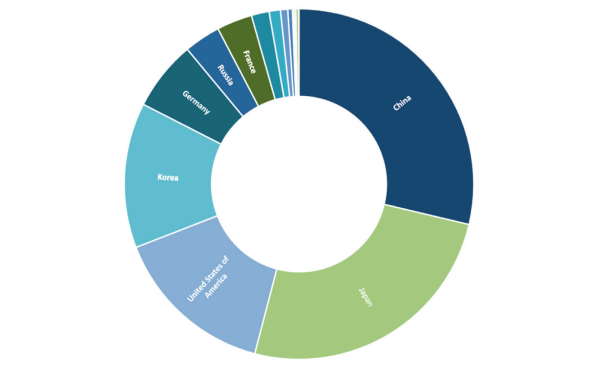Abstract
Transitioning globally interconnected, hard-to-abate industry and transport to cleaner fuels without disrupting their strategic, economic, and social advantages is a major challenge. Much of this transition depends on timely, affordable, shared, and scaled-up access to emerging green technologies.
Developed countries own most green technologies, leverage intellectual property rights, and subsidise domestic green technology deployment, while also—aided by an inert World Trade Organisation (WTO)—erecting trade barriers to protect their own industries.
Billions of people, especially in developing countries, will be unable to undertake inclusive clean energy transitions without green technologies. This T20 policy brief establishes why it is crucial for the technology- and market-rich G20 countries (and the G20 itself) to establish norms for shared technology access and co-development, and how a Tech20 Engagement Group could facilitate this within the G20.
- The Challenge
The International Energy Agency (IEA) projects that globally installed renewable energy (RE) capacity must triple in the next seven years for the world to remain on track to achieve net zero emissions[a] around mid-century.[1] Extrapolated, this entails a hike from ~3026 GW installed RE capacity in 2021 (including 1186 GW hydroelectric, 853 GW solar, and 823 GW wind power)[2] to ~9090 GW in 2030. This is especially relevant for the G20 countries, which collectively consume ~85 percent of global fossil fuels,[3] and except Mexico, have all set net zero targets.[4]
The scope of this massive challenge is reaffirmed by the fact that solar, wind, and biofuels-based RE accounts for just about 5 percent of global energy consumption, nearly all of which (~93 percent) is collectively consumed by G20 countries alone.[5] Exponentially increasing installed RE capacity and its share in energy consumption worldwide requires rapid scaling-up of the clean energy infrastructure, which is only possible with equitable access to emerging technologies to decarbonise hard-to-abate industry and transport.
Achieving scale and equity in clean energy technologies through actual co-development and/or co-ownership has thus far been a low multilateral priority, despite many discussions and perfunctory nods. In 2012, only 1.5 percent of energy sector patents were co-owned, and 2 percent were shared equally by developing and developed country entities.[6] A decade later, most of the world’s RE and green hydrogen patents are still held by a few G20 countries,[7],[8] which closely guard their technology using strong intellectual property (IP) protection.
Figure 1: Technology gaps within the G20 – Patent applications by G20 countries, published by PCT
Source: CEEW analysis[9]
A key piece of the technology puzzle is reflected in data from the Patent Cooperation Treaty (PCT), administered by the World Intellectual Property Organisation. The PCT facilitates patent protection by allowing simultaneous filing of patent applications in its 157 member countries.[10] The application data, published 18 months after filing, provides useful insights into global technology trends (though applications do not always convert into patent grants).
Analysis of PCT patent applications for clean energy technologies (solar, wind, geothermal, and fuel cells) published between 2000 and 2023 reveals that:
- G20 countries dominate global RE technology, owning ~85 percent of published RE patent applications, comprising 49,721 of the total 58,531 applications,[11] and
- Five countries (Japan, USA, Germany, China, and the Republic of Korea) hold ~85 percent of the G20’s published RE patent applications (Figure 1), revealing a technology gap even within the G20.
Figure 2: Technology gaps within the G20 – PCT patents granted, by country of origin
Source: CEEW analysis[12]
The technology gap between the G20 and other countries (and even within the G20) is further confirmed by analysing the origin of PCT patents granted for environmental technologies (solar, wind, hydro, geothermal, fuel-cell, and waste management):[b]
- The G20 owns ~91 percent of the PCT patents granted in environmental technology between 2000 and 2021, comprising 284,346 of 313,730 patents,[13] and
- Five G20 countries (China, Japan, USA, the Republic of Korea, and Germany) account for ~85 percent of all PCT environmental technology patents granted between 2000 and 2021 (Figure 2).
While the G20 collectively dominates RE and environmental technology patents, there is a substantial technology gap within the grouping as just five countries own 85 percent of these critical technologies.
The G20’s technology dominance is expensive. Leading countries spent significant shares of their GDP on R&D in 2021, including the Republic of Korea (~5 percent), USA, Japan, and Germany (~3 percent each), and China (~2 percent).[14] Many G20 countries also provide monetary incentives for green technology patent filings. The European Union’s (EU) IP action plan subsidises patent filing for small and medium enterprises,[15] Australia’s patent box scheme grants a 40 percent corporate tax discount for clean energy patents,[16] Japan has a US$16 billion green technology fund[17] and gives tax breaks for carbon neutral investments,[18] and Korea offers tax breaks for R&D funding in 48 carbon neutral technologies.[19]
On the deployment side, the global transition to net zero emissions could cost up to US$ 9.2 trillion annually in physical asset creation, including setting up infrastructure based on new technologies, adding up to US$275 trillion by 2050.[20] Such expenditure is typically beyond the economic capacity of developing and least developed countries, and even G20 emerging economies. Another energy transition challenge faced by many countries is the lack of access to scarce resources concentrated only in a few regions, including critical minerals and their processing technologies.[21]
An immediate and overwhelming energy transition barrier is, therefore, created where a handful of countries own the lion’s share of clean energy technologies and are unwilling to share it without stringent licensing conditions or steep commercial premiums.
IP reforms to enable timely, affordable, shared, and scaled-up access to technology and deployment are urgently needed to ensure global energy and resource security, build resilient and secure supply chains, promote sustainable green growth, and transition to a low-carbon future.
Technology sharing: Broken promises
IP laws have been sharpened over many centuries. In 1623, Britain’s Statute of Monopolies stopped the government from granting monopolies and gave the “true and first inventor” fourteen years of exclusive control over an invention.[22] While this justifiably gave the inventor years to improve and monetise the invention, it restricted timely and affordable dissemination of important scientific and technological breakthroughs to the public.
Since the Industrial Revolution and the formalisation of IP rights in the late 19th century, technology dominance has created, or exacerbated, global inequities. Technological advancements, along with the abundant capital amassed by developed countries, define “techno-economic paradigms”—clusters of countries, institutions, infrastructure, industries, technology, and products—that characterise each technological revolution.[23] Each new paradigm helps technology leaders pull further ahead, leaving the less privileged behind.
These inequities are sector-agnostic and pervasive. Almost all (96 percent) of the ~3 billion people lacking internet access reside in developing countries.[24] Over 670 million people will remain without electricity access in 2030—more than two centuries after the invention of electric lighting.[25] Will incoming low-carbon and digital technology revolutions deepen these inequities?
Recognising the socio-economic threat posed by technology and finance gaps, developing countries have been pushing to include ‘technology transfer’ in international trade and climate agreements.[26] However, even after half a century of technology transfer promises, the innovation, development, and deployment of low-carbon technologies remains the bastion of a few countries, which consequently determine the pace and scale of technology diffusion.[27]
Despite the global imperative to achieve Sustainable Development Goals and net zero emissions, indigenous capacity building efforts continue to be restricted by multilateral trade agreements. For example, domestic content requirements (DCR) are policy tools to incentivise manufacturers and producers to license innovative technology and build domestic capacity to promote technology innovation. But such initiatives—even for clean energy systems—are frequently thwarted by rigid free trade rules.
In one case, Canada was forced to modify its feed-in tariff and DCR schemes after the WTO Dispute Settlement Board (DSB) ruled it a breach of WTO agreements.[28] India also mandated DCRs for the public procurement of solar cells to ramp up its renewables rollout but was forced to withdraw after the DSB ruled that India’s DCRs breach its free trade agreements.[29] However, potential adverse rulings by the DSB on the US’s subsidies and local content requirements are pending review by the long-vacant WTO Appellate Body,[30] appointments to which have been stalled due to the US’s insistence on fundamental reforms in the dispute settlement system.[31]
Even as the WTO lies inert, developed countries are erecting new trade barriers to protect their green industries. The EU’s Carbon Border Adjustment Mechanism (CBAM) intends to monitor emissions embedded in its imports by the end of 2023 and allow the EU to price carbon emissions by 2026. With a US$44 per tonne carbon price, the CBAM could annually cost developing countries an extra US$5.9 billion for exports, and benefit developed countries by US$2.5 billion.[32] The US is also considering a similar border adjustment mechanism—the Clean Competition Act.[33]
Subsidies are also used to boost domestic industry and undercut international competitors. The US’s Inflation Reduction Act (IRA) provides approximately US$70 billion in loans and subsidies for clean energy infrastructure, US$9.5 billion for clean hydrogen infrastructure, and a US$7500 line of credit to consumers to purchase electric vehicles.[34] The EU has annually spent around US$74 billion on clean energy subsidies since 2015,[35] and eased subsidy rules for its member countries to counter the IRA.[36] Canada and Australia have joined the subsidy race, unveiling roughly US$66 billion[37] and US$17 billion[38] in subsidies and tax credits respectively.
Technology and patent sharing provisions have failed to bridge access gaps even in the worst of times. During the COVID-19 pandemic, some developed countries quickly invented vaccines, but exorbitant prices kept these potentially lifesaving drugs and formulae out of the hands of their poorer counterparts. A patent waiver – permitted under the TRIPS agreement to “protect public order or morality, including to protect human, animal or plant life or health or to avoid serious prejudice to the environment” – was proposed by over 100 countries to scale vaccine production[39] but was stonewalled by a few countries (Meredith 2021). At the peak of the pandemic, 75 percent of vaccines went to 10 countries, many of which allowed extra doses to expire, while 98 percent of people in low-income countries were partially or entirely unvaccinated (the US alone discarded 180,000 doses by March 2021)[40]. As of November 2021, American pharma giants Pfizer and Moderna delivered less than 1 and 0.2 percent respectively of their vaccines to low-income countries, while earning a US$1,000 profit every second from vaccine sales in rich countries.[41]
Even the G20 has had little impact on technology cooperation for COVID-19 vaccines, despite crucial topics like voluntary IP licensing, a COVID-19 accelerator, technology transfer hubs, and public-private partnerships for digital and health technologies being raised during three consecutive Summits.
The COVID-19 vaccine case is not isolated. Rather, IP waivers and compulsory licensing have always been deeply contested. Most globally accepted cases of compulsory licensing were to curb the AIDS epidemic. India, Brazil, Indonesia, and Thailand faced severe backlash when they allowed compulsory licensing to reduce the cost of lifesaving drugs.[42]
- The G20’s Role
The UN Conference on Trade and Development’s 2023 Technology and Innovation Report states that “… the international community should align the international protection of IPRs with the principle of “common but differentiated responsibility and respective capabilities” set out in the UNFCCC. Manufacturers in technologically weak and less-diversified countries should be allowed to imitate the production of more technologically advanced economies”.[43]
Technology warfare, presided over by inert multilateral organisations, erodes global trust and reliance on the principle of technology as a public good and altruistic technology sharing. The WTO has initiated discussions to align trade-related policies with climate and environmental commitments, including a free trade and IP protection mechanism for environmental technologies.[44] Unfortunately, there is no deadline set for decisions. WTO tariff and IP agreements allow exceptional use of patents without authorisation from owners, subject to fair compensation, but whether climate and energy transition matters qualify for such exceptions is legally ambiguous.
This sets a disheartening precedent for countries facing high energy demand, pressure to decarbonise, and technology deficits in the race to achieve common global goals like sustainable development and climate change mitigation and adaptation, which need all countries to act in tandem.
Figure 3: G20 Summit outcomes on clean energy technology cooperation, co-development, transfer, and IPR; and COVID-19
 |
Source: CEEW analysis
The G20 acknowledges the need for clean energy technology cooperation but has made limited progress. Figure 3 recounts significant summit outcomes on clean energy technology cooperation, co-development, transfer, and IP sharing. It shows the G20’s emphasis on technology cooperation and transfer of sustainable energy and innovative technologies on mutually agreed terms. Salient outcomes include:
- Argentina, 2018: The G20 agreed on the need for Multilateral Development Banks (MDBs) to facilitate technology transfer.
- Japan, 2019: Technology cooperation progressed from theory to practice with the establishment of the Research and Development 20 (RD20) Engagement Group to facilitate scientific cooperation between G20 research institutions.
- Saudi Arabia, 2020: Circular Carbon Economy and hydrogen technology were highlighted for technology cooperation.
- Indonesia, 2022: The G20 expanded the scope of technology cooperation to support developing countries adopt and scale-up clean energy systems.
India’s G20 presidency in 2023 takes these discussions forward by highlighting the need for international cooperation to close clean energy technology gaps in carbon capture, utilisation, and storage, electrolysers for green hydrogen, high efficiency fuels cells, advanced cell chemistry for battery storage, and small modular nuclear reactors.
- Recommendations to the G20
Tech20: A G20 Engagement Group on technology sharing
This policy brief recommends the creation of a Tech20 Engagement Group, comprising G20 country representatives, industry leaders, and civil society members, to facilitate technology cooperation, co-development and sharing, and IP reforms between the G20 countries. The Tech20 Engagement Group could be a new entity or a subset of the RD20 to avoid duplication.
Tech20 should focus on green technologies, with three time-bound outputs:
- Technology transfer patent pool/bank to club IP for the G20: A voluntary, open access, patent pool for green technologies will allow individual G20 countries to contribute patents to, and draw from, the pool/bank. This process will also help feed into WTO patent discussions.
- Technology co-development: The RD20 facilitates exchanges between G20 scientific institutions to co-develop technology. Tech20 could further this collaboration to democratise knowledge by becoming a platform for the G20 to share scientific knowledge and resources, conditioned upon the co-ownership of any resulting technology.[45]
- Enhanced financing for green technologies: Indigenous development and deployment of green technologies and infrastructure by the G20, suited to different countries’ specific circumstances, needs financing beyond shared technologies and IP. Tech20 could be a platform for the G20 to share their requirements and discuss the scope and procurement of such financing.
Clean energy technologies are at the frontier of human innovation. Policy choices made today will either create the sustainable and equitable future envisioned in global climate goals or exacerbate developmental gaps. In an increasingly polarised world, it is crucial for the G20 to adopt new models of collaboration on issues that are important to its members and the world at large. Containing global warming to 1.5°C requires a 43 percent reduction in carbon emissions by 2030.[46] The decisions and actions of the G20, which consumes ~85 percent of the world’s fossil fuels as well as ~93 percent of its renewable energy, has deep connotations for the global energy transition.
The G20 owns ~91 percent of all environmental technology patents granted by the PCT between 2000 and 2021, a count that has doubled since 2012.[47] This has two implications: most of these patents are held by five G20 countries, and most will retain patent protection till well after 2030. This technology stockpile, if not shared now – first within the G20, and then worldwide – will be of little use if the 1.5°C mark is breached, leading to devastating socio-economic consequences for future generations.
The G20, comprising most of the world’s most socio-economically prosperous countries, housing two-thirds of the global population, has had a major role in precipitating the energy and climate crises. But the privilege of the G20, as one of the premier multilateral groupings of this century, also makes it the key to solving said crises. The time for the G20 to act decisively is now.
Attribution: Tulika Gupta, Shuva Raha, and Hemant Mallya, “The G20 Imperative for Global IP Reform to Facilitate Clean Energy Transitions,” T20 Policy Brief, July 2023.
[a] A net zero emissions scenario requires the deployment of new low emission energy sources equivalent to the entire energy supply added worldwide over the last 15 years by 2030 (IEA 2022).
[b] The available data on patents granted under the PCT does not include segregation based on the type of environmental technology.
[1] International Energy Agency, World Energy Outlook: 2022, Paris, IEA, 2022, https://www.iea.org/reports/world-energy-outlook-2022.
[2] “Installed electricity capacity worldwide in 2021, by source,” Statista, accessed April 2023, https://www.statista.com/statistics/267358/world-installed-power-capacity/
[3] “BP Statistical Review of World Energy 2022,” BP, 2022, https://www.bp.com/en/global/corporate/energy-economics/statistical-review-of-world-energy.html.
[4] “Net Zero Tracker,” Net Zero Tracker, accessed April 11, 2023, https://zerotracker.net.
[5] BP Statistical Review 2022.
[6] Bernice Lee, Felix Preston, Jaakko Kooroshy, Rob Bailey, and Glada Lahn, Resources Futures, A Chatham House Report, Chatham House, 2012, https://www.chathamhouse.org/sites/default/files/field/field_document/Executive%20Summary%20Resources%20Futures.pdf.
[7] James Nurton, “Patenting trends in renewable energy,” WIPO, January 11, 2023, https://www.wipo.int/wipo_magazine/en/2020/01/article_0008.html.
[8] “Patent insight report: Innovation trends in electrolysers for hydrogen production,” IRENA, accessed January 11, 2023, https://public.tableau.com/views/IRENA_Electrolysers_Patents_Insights/Electrolysers_patent_insight?:showVizHome=no&embed=yes.
[9] “WIPO IP Statistics Data Center,” WIPO, accessed April 10, 2023, https://www3.wipo.int/ipstats/pmhindex.htm?tab=pct&lang=en.
[10] “The PCT now has 157 Contracting States,” WIPO, accessed April 10, 2023, https://www.wipo.int/pct/en/pct_contracting_states.html.
[11] “WIPO IP Statistics Data Center”
[12] “WIPO IP Statistics Data Center”
[13] “WIPO IP Statistics Data Center”
[14] “Gross domestic spending on R&D,” OECD, accessed April 11, 2023, https://data.oecd.org/rd/gross-domestic-spending-on-r-d.html.
[15] “Intellectual property action plan implementation,” European Commission, accessed April 10, 2023, https://single-market-economy.ec.europa.eu/industry/strategy/intellectual-property/intellecual-property-action-plan-implementation_en.
[16] “Patent Box Policy Design,” S&T Australia, last modified August 16, 2021, https://treasury.gov.au/sites/default/files/2022-02/c2021-177849-science-and-technology-australia.pdf.
[17] “JPY 2 trillion (around USD 16 Billion) Green Innovation Fund under the Green Development Strategy for carbon neutrality in Japan by 2050,” Baker McKenzie, last modified April 13, 2022, https://www.bakermckenzie.com/en/insight/publications/2022/04/green-innovation-fund.
[18] “Japan’s 2021 Tax Reform introduces tax incentives for carbon neutrality and digital transformation,” EY Global, last modified April 15, 2021, https://www.ey.com/en_gl/tax-alerts/japan-s-2021-tax-reform-introduces-tax-incentives-for-carbon-neutrality-and-digital-transformation .
[19] Kim Soo-yeon, “S. Korea to expand tax incentives for R&D on carbon neutrality technology,” Yonhap News Agency, January 6, 2022, https://en.yna.co.kr/view/AEN20220106002500320.
[20] “The economic transformation: What would change in the net-zero transition,” McKinsey & Co., accessed March 23, 2023, https://www.mckinsey.com/capabilities/sustainability/our-insights/the-economic-transformation-what-would-change-in-the-net-zero-transition.
[21] CEEW, IEA, UC-DAVIS and WRI, Addressing Vulnerabilities in the Supply Chain of Critical Minerals, New Delhi, Council on Energy, Environment and Water, 2023, https://www.ceew.in/publications/addressing-vulnerabilities-in-the-supply-chain-of-critical-minerals
[22] “History and Sources of Intellectual Property Law,” Lawshelf Educational Media, accessed April 2023, https://lawshelf.com/coursewarecontentview/history-and-sources-of-intellectual-property-law.
[23] United Nations Conference on Trade and Development, Technology and Innovation Report, Geneva, UNCTAD, 2021, https://unctad.org/page/technology-and-innovation-report-2021.
[24] International Telecommunications Union, Measuring digital developments: Facts and figures, Geneva, ITU, 2021, https://www.itu.int/en/ITU-D/Statistics/Documents/facts/FactsFigures2021.pdf.
[25] United Nations, The Sustainable Development Goals Report 2022, New York, UN, 2022, https://www.un.org/sustainabledevelopment/energy/.
[26] United Nations, Compendium of International Arrangements on Transfer of Technology : Selected Instruments, New York, UN, 2001, https://unctad.org/system/files/official-document/psiteipcm5.en.pdf.
[27] Bernice Lee, Ilian Iliev, and Felix Preston, Who Owns Our Low Carbon Future? Intellectual Property and Energy Technologies, A Chatham House Report, Chatham House, 2009, https://www.chathamhouse.org/sites/default/files/field/field_document/Executive%20Summary%20Who%20Owns%20our%20Low%20Carbon%20Future.pdf.
[28] “Canada — Certain Measures Affecting the Renewable Energy Generation Sector,” WTO, accessed April 17, 2023. https://www.wto.org/english/tratop_e/dispu_e/cases_e/ds412_e.htm.
[29] “India – Certain measures relating to solar cells and solar modults,” WTO, accessed April 17, 2023, https://www.wto.org/english/tratop_e/dispu_e/cases_e/ds456_e.htm.
[30] Ravi Kanth, “India wins solar case agaisnt the US at WTO,” Live Mint, May 18, 2022, https://www.livemint.com/news/india/india-wins-solar-case-against-us-at-wto-1561634893762.html.
[31] “Members continue push to commence Appellate Body appointment process,” WTO, accessed April 2023, https://www.wto.org/english/news_e/news22_e/dsb_28mar22_e.htm.
[32] United Nations Conference on Trade and Development, An EU Carbon Border Adjustment Mechanism: Implications for developing countries, Geneva, UNCTAD, 2021, https://unctad.org/publication/european-union-carbon-border-adjustment-mechanism-implications-developing-countries#:~:text=The%20introduction%20of%20a%20CBAM,less%20carbon%20intensive%20production%20processes.
[33] “S.4355 – Clean Competition Act,” Sheldon Whitehouse, accessed April 10, 2023, https://www.congress.gov/bill/117th-congress/senate-bill/4355.
[34] The White House, Government of the United States of America, Building a Clean Energy Economy: A guidebook to the IRA’s investments in clean energy and climate action, Washington DC, 2023, https://www.whitehouse.gov/wp-content/uploads/2022/12/Inflation-Reduction-Act-Guidebook.pdf.
[35] Richard Bravo, “Europe Banks on Its €72 Billion to Counter Biden’s Green Payouts,” Bloomberg, February 26, 2023, https://www.bloomberg.com/news/articles/2023-02-26/europe-incentives-on-clean-energy-rival-biden-s-green-subsidies#xj4y7vzkg.
[36] “EU loosens subsidy rules for green tech,” Euractiv, last modified March 10, 2023, https://www.euractiv.com/section/energy-environment/news/eu-loosens-subsidy-rules-for-green-tech/.
[37] Maura Forrest, “Canada’s C$80B response to U.S. clean energy push: ‘We will not be left behind’,” Politico, March 29, 2023, https://www.politico.com/news/2023/03/29/canada-u-s-clean-energy-ira-00089284.
[38] “Australian Budget commits A$25bn to clean energy and renewables,” Global Australia, accessed April 10, 2023, https://www.globalaustralia.gov.au/news-and-resources/news-items/australian-budget-commits-a25bn-clean-energy-and-renewables-projects.
[39] “Waiver from Certain Provisions of the TRIPs Agreement for the Prevention, Containment and Treatment of COVID-19,” WTO, accessed April 10, 2023, https://pop-umbrella.s3.amazonaws.com/uploads/e9989bf5-7d26-4d4d-8336-8d37f1577529_W669.pdf?key=.
[40] Elisabeth Mahase, “Covid-19: Countries dump vaccines as demand slumps and sharing proves difficult,” BMJ, July 27, 2021, https://www.bmj.com/content/374/bmj.n1893.
[41] “Pfizer, BioNTech and Moderna making $1,000 profit every second while world’s poorest countries remain largely unvaccinated,” Oxfam International, accessed April 2023, https://www.oxfam.org/en/press-releases/pfizer-biontech-and-moderna-making-1000-profit-every-second-while-worlds-poorest.
[42] Asok Awasthy, “Compulsory Licensing For Public Health And USA’s Special 301 Pressure: An Indian Experience,” Journal of Intellectual Property Rights (Sep 2019): 125-131, http://nopr.niscpr.res.in/handle/123456789/54321.
[43] United Nations Conference on Trade and Development, Technology and Innovation Report 2023: Opening green windows, technological opportunities for a low carbon world,” New York, UNCTAD, 2023, https://unctad.org/system/files/official-document/tir2023_en.pdf.
[44] “WTO TESSD Ministerial Statement on Trade and Environmental Sustainability,” WTO, accessed April 11, 2023, https://docs.wto.org/dol2fe/Pages/SS/directdoc.aspx?filename=q:/WT/MIN21/6R2.pdf&Open=True.
[45] Arunabha Ghosh, Nandini Harihar, and Prayank Jain, “Co-development of technologies of the future,” Stockholm Environment Institute and CEEW, 2022, https://www.ceew.in/publications/co-development-technologies-future.
[46] Intergovernmental Panel on Climate Change, AR6 Synthesis Report: Climate Change 2023, Geneva, IPCC, 2023, https://www.ipcc.ch/report/sixth-assessment-report-cycle/.
[47] “WIPO IP Statistics Data Center”







